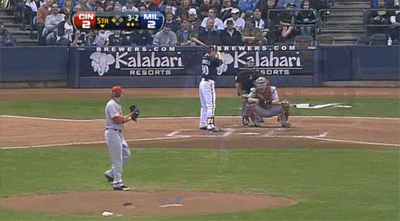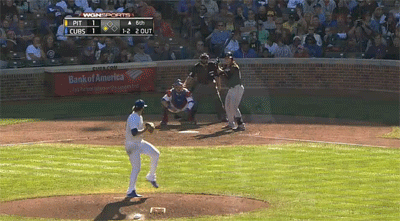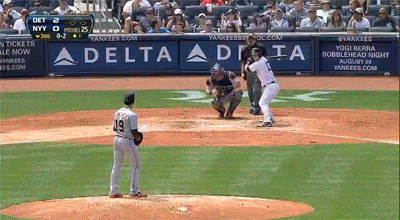This week, we’re focusing on pitch velocity and identifying the arms who have seen a big change in their fastball speeds over the last couple of years. On Monday, we looked at the players who are on the velocity downslope, with offerings that fall under the radar-gun readings of their past. Today we study the other side of the coin, drawing attention to those pitchers who have added fuel to their heat over the past couple of seasons.
Consistent with the findings of version 1.0 of this series, the group of Over-the-Radar pitchers is much more selective than the club of velocity-decliners, a trend that follows the expectation that pitchers will lose velo as they age and accrue more mileage on their arms. More notable was the fact that fewer pitchers qualified for the distinction than last year, as the list of 10 pitchers who had established a multi-year incline has whittled down to five players this time around.
Here's a refresher on the rules: We’re looking at the three-year period from 2011-13. To qualify as “Over the Radar” a pitcher had to have thrown at least half a mile per hour harder in 2013 than he did in each of the previous two seasons, with an increase of a full tick relative to at least one of those years. He also had to throw at least 500 pitches labeled as fastballs or sinkers by BrooksBaseball.net in each of the past three seasons. The numbers in the charts were calculated based on a weighted average of the pitch-speeds on four-seam fastballs and sinkers in each season.
Before we get to the current crop of harder throwers, let's take a moment to review last year's list to see how they've progressed.
|
Player |
MPH Difference, 2011-2013 |
MPH Difference, 2012-2013 |
2013 |
2012 |
2011 |
|
-1.6 |
-3.5 |
93.4 |
96.9 |
95.0 |
|
|
-1.3 |
-1.9 |
93.5 |
95.4 |
94.8 |
|
|
0.1 |
-1.0 |
93.2 |
94.2 |
93.1 |
|
|
0.1 |
-0.5 |
91.1 |
91.6 |
91.0 |
|
|
0.1 |
-0.5 |
92.5 |
93.0 |
92.4 |
|
|
0.2 |
-0.3 |
87.6 |
87.9 |
87.4 |
|
|
0.4 |
-1.6 |
91.1 |
92.7 |
90.7 |
|
|
0.5 |
0.0 |
93.8 |
93.8 |
93.3 |
|
|
1.2 |
-0.1 |
92.1 |
92.2 |
90.9 |
|
|
2.3 |
-0.5 |
91.7 |
92.2 |
89.4 |
Alexi Ogando and David Price both appeared in Monday’s piece due to their precipitous drops in velocity last season. They also dealt with injury issues that effectively siphoned their gas, as each pitcher was sidelined for chunks of the season when his throwing arm went on the blink.
The majority of last year's Over the Radar pitchers ended up giving back a chunk of their gained velocity, falling in line with their numbers from two years ago. The situation is not as dire as it may seem at first glance, given that each of these pitchers had been on a multi-year rise coming into the 2013 season and settled down to a point that was slightly above their previously-established speeds.
There are a few notable names among the middle six-pack of pitchers on the above chart: 1) Rick Porcello endured a particularly heavy drop from 2012-13, and he didn't have the injury excuses of the other lead balloons; 2) teammate Max Scherzer dropped a full tick from 2012, but the Cy Young award in his trophy case indicates that there were no ill effects from a functional standpoint; and 3) Jordan Zimmermann is the only pitcher who completely maintained the velocity gains that put him Over the Radar a year ago, with the same average velo in 2013 as in 2012.
James Shields just missed the Zimmermann prize, with an average velocity that was within a rounding error of the previous season. At age 31, Shields essentially retained the large velo bump he had enjoyed in 2012, continuing an impressive run of increasing pitch speed that has lasted throughout his eight-year career. Chris Tillman topped the “Over the Radar” charts a year ago, and though he gave back a half-tick of velocity, the right-hander made 33 starts and accumulated more than 200 innings pitched (his previous high at the MLB level was 86 frames).
Two additional pitchers cracked last year's list, but the stricter thresholds of this year's iteration would have kept them at bay. (I didn’t require a full-mph improvement over one of the past two seasons in order to qualify for the list last season.) Those two pitchers were Jason Hammel and Mike Leake, and though Hammel fell backward and finished below his 2011 velo, Leake continued his ascension and added enough oomph to qualify for this year's list.
|
Player |
MPH Difference, 2011-2013 |
MPH Difference, 2012-2013 |
2013 |
2012 |
2011 |
|
1.1 |
0.6 |
91.0 |
90.4 |
89.9 |
|
|
Mike Leake |
1.4 |
0.7 |
90.2 |
89.5 |
88.8 |
|
1.5 |
0.6 |
93.9 |
93.3 |
92.4 |
|
|
1.5 |
1.5 |
93.1 |
91.6 |
91.6 |
|
|
1.9 |
1.6 |
94.0 |
92.4 |
92.1 |
J.A. Happ has the most modest of gains on the list, with numbers that just cleared the bar for admission. Happ has a long track record of maintaining velocity, having upped the ante on his radar-gun readings by modest margins throughout his seven-year career.

When looking at the mechanical underpinnings of velocity, torque plays by far the largest role. In the case of Happ, his degree of hip-shoulder separation has stayed very similar across the years, though the contributions of his hips and shoulders have changed a bit with respect to generating torque. He has a good measure of hip rotation prior to firing his shoulders thanks to a strong delay of trunk rotation, as well as an upper-body twist with a pronounced scapular load, but over time he has tamed the upper-body portion in favor of some extra hip-rotation in creating separation. The result is a higher average velocity. Consider the following stills of Happ across the years (2010 on the left, 2013 on the right).


In similar fashion, Leake has slowly risen through the velocity ranks, and though his 2013 average velocity of 90.2 mph is nothing to write home about, it does represent a nice climb from the 88.8-mph average of a few years ago. The key to his improvement has been a better delay of trunk rotation, allowing his hips to rotate a bit longer after foot strike in order to increase separation. This was crucial for Leake, who had a tendency in the past to fire his shoulder axis immediately after reaching foot strike. The hips and shoulders fired in near-unison a few years ago, as he utilized a hip-whip strategy to generate most of his arm speed.
Leake has also improved the second gear of his momentum, as he used to slow down just before reaching foot strike but now keeps his pace until the front foot hits the ground. The resulting timing pattern has allowed him to maintain the same rhythm of trunk rotation while reaching foot strike a touch sooner, giving him the opportunity to have both feet planted before firing the upper half. It’s also worth noting that momentum and the slope of the mound account for approximately 20 percent of a pitcher's velocity, and Leake is reaping some extra kinetic energy with the bolder burst to the plate. Check out the following GIFs and focus on his pace between max leg lift and foot strike.


Velocity is the best arrow in Jake Arrieta's quiver, and though he pitched only 75 innings and threw just 809 fastballs-plus-sinkers, his fast-pitch performance stood out in a season in which his breaking balls were rocked. Mechanical consistency is not on his resume, adding to the volatility behind his radar-gun readings and leading to a lot of walks, but Cub fans can take solace in the fact that Arrieta rediscovered the lost velocity of his youth. He doesn't use much of a load with the upper half to create separation, with torque that is almost entirely driven by his hip rotation and delayed trigger after foot strike.

Prior to 2013, Anibal Sanchez's fastball was moseying along on a modest yet stable upward trajectory, parked in the 91-92 mph range on average. Then, in his first full season in Detroit, the velo spiked. The Tigers are no strangers to gas-pumping pitchers, with studs such as Max Scherzer and Justin Verlander who are known for their hard stuff, but the sudden blast of heat coming from Sanchez's right arm helped to drive the best season of his career, which included a league-leading ERA and a K rate that broke 27 percent. There were mechanical links to Sanchez’s uptick in pitch speed, as he incorporated a reverse-twist into max leg lift that was much more pronounced than in his Marlins days. The strategy helped him to keep his upper half closed a bit longer during the stride phase and enabled his delay of trunk rotation post-foot-strike. The difference in arm speed was stark, and the rotational velocity of his shoulder axis serves as an indicator of this disparity when comparing his 2012 delivery (first GIF below) to that of 2013 (second GIF).


By far the biggest blip on the radar is that of Homer Bailey, who has jumped nearly two mph over the past two seasons, including a leap of 1.6 mph over the course of a calendar year. The fact that he has ratcheted up the heat while maintaining superior command of the pitch has fueled his spike in performance. The deadly combination also inspired the Reds to give Bailey a six-year extension for $105 million, and his development has turned the right-hander from a once-disappointing prospect into one of the more feared pitchers in the National League.
Once again, improved timing of trunk rotation has played a key role in the velocity jump, as Bailey exhibited a greater delay prior to firing his bullets last season. The difference is subtle, and perhaps easier to see when Bailey is pitching from the stretch. Looking at the following GIFs (2012 first, then 2013), the right-hander begins the entire upper-body sequence a bit earlier in the 2012 clip, from separating his hands to raising his arms and then triggering rotation. The slight delay of these elements in 2013 has allowed him to use the same timing pattern of momentum and stride to generate even greater torque, resulting in far more flaming graphics on his FOX telecasts.


*****
In Monday's piece on pitchers who were on the downslope of the velocity scale, I wrote about the connection between poor posture and lower readings on the radar gun. The idea was not that spine-tilt takes velocity off the ball, but rather that the associated wear on the throwing shoulder leads to slower fastballs over the long haul. Therefore, I would not necessarily expect that the over-radar pitchers would have minimal spine-tilt, as posture is not directly tied to velocity generation (though there could be an association in which solid posture creates a buffer against shoulder fatigue, thereby allowing these pitchers to reap the most benefit from mechanical increases to torque). With that in mind, I went ahead and checked out the posture grades that I doled out in the 2014 Starting Pitcher Guide for the five pitchers who cracked the over-radar list.
|
Player |
Posture |
|
Happ |
50 |
|
Leake |
50 |
|
Arrieta |
55 |
|
Sanchez |
50 |
|
Bailey |
60 |
There are a lot of average grades there, and the only pitcher with plus posture is Bailey, though it is notable that there is not a single sub-average rating among the group. Obviously this is a paltry sample so we can’t draw any conclusions, but it seems that there is some evidence to support the posture-velocity theory.
Thank you for reading
This is a free article. If you enjoyed it, consider subscribing to Baseball Prospectus. Subscriptions support ongoing public baseball research and analysis in an increasingly proprietary environment.
Subscribe now
hmamis
I agree with James if looking strictly at performance stats, and velocity is connected as a major driver of strikeouts. But we are looking at different ends of the process-outcome interaction, which could be even more predictive in theory, but we currently lack the means to adequately measure all of the variables in order to do a comprehensive study. You might be able to find something with the sample of pitchers who gain velocity rather than lose it, but you run into serious issues with sample size.
Really cool question.
I'm probably on the left side of the bell curve of Cubs fans in terms of expectations for Arrieta. I feel like he's a reliever, or a mess. Do you see cause for hope that he can stick in the rotation, though? Or is that fastball playing up just another sign to see whether it could play up even further in bursts?
The big issue to me is his repertoire. Without a reliable changeup, and with a slider that has minimal velocity differential from the fastball, it seems that his stuff is best suited for the bullpen.
Which one of these 5 do you see maintaining their velocity gains in 2014? I'm not sure if you were leaning toward Bailey with your comment at the end, but I would guess it makes sense if the relatively better posture takes away some of the wear on the shoulder.
For these reasons, it is safer to say somebody like Happ, given that he has the most modest of gains to maintain and he has demonstrated an incline of velo throughout his career - plus he has made the mechanical improvements to justify it.
That said, it's just a potential indicator and certainly not a death knell. As you mentioned, better mechanical efficiency is a buffer against the risk, but in a vacuum the uptick of velo does present some additional risk.